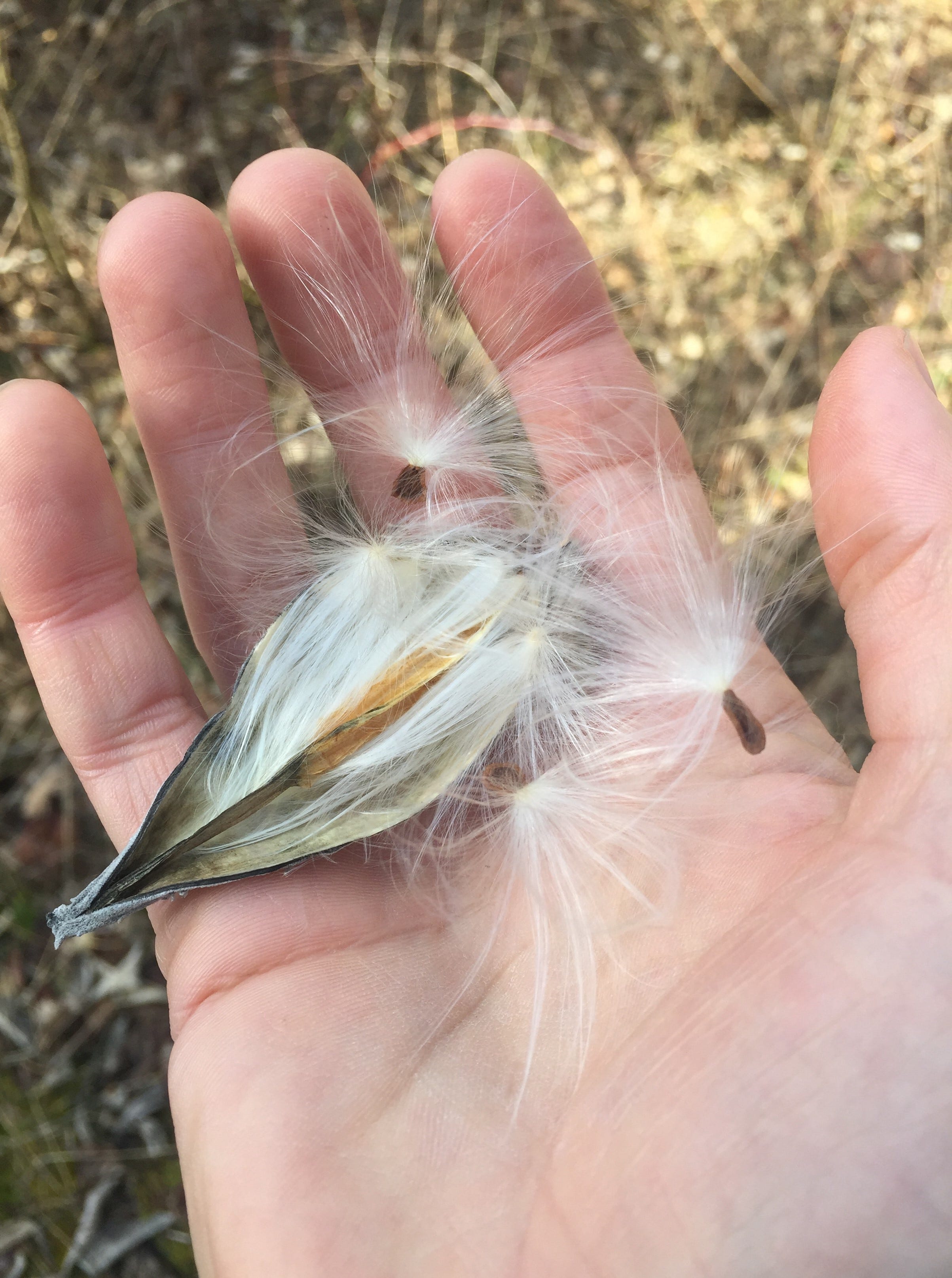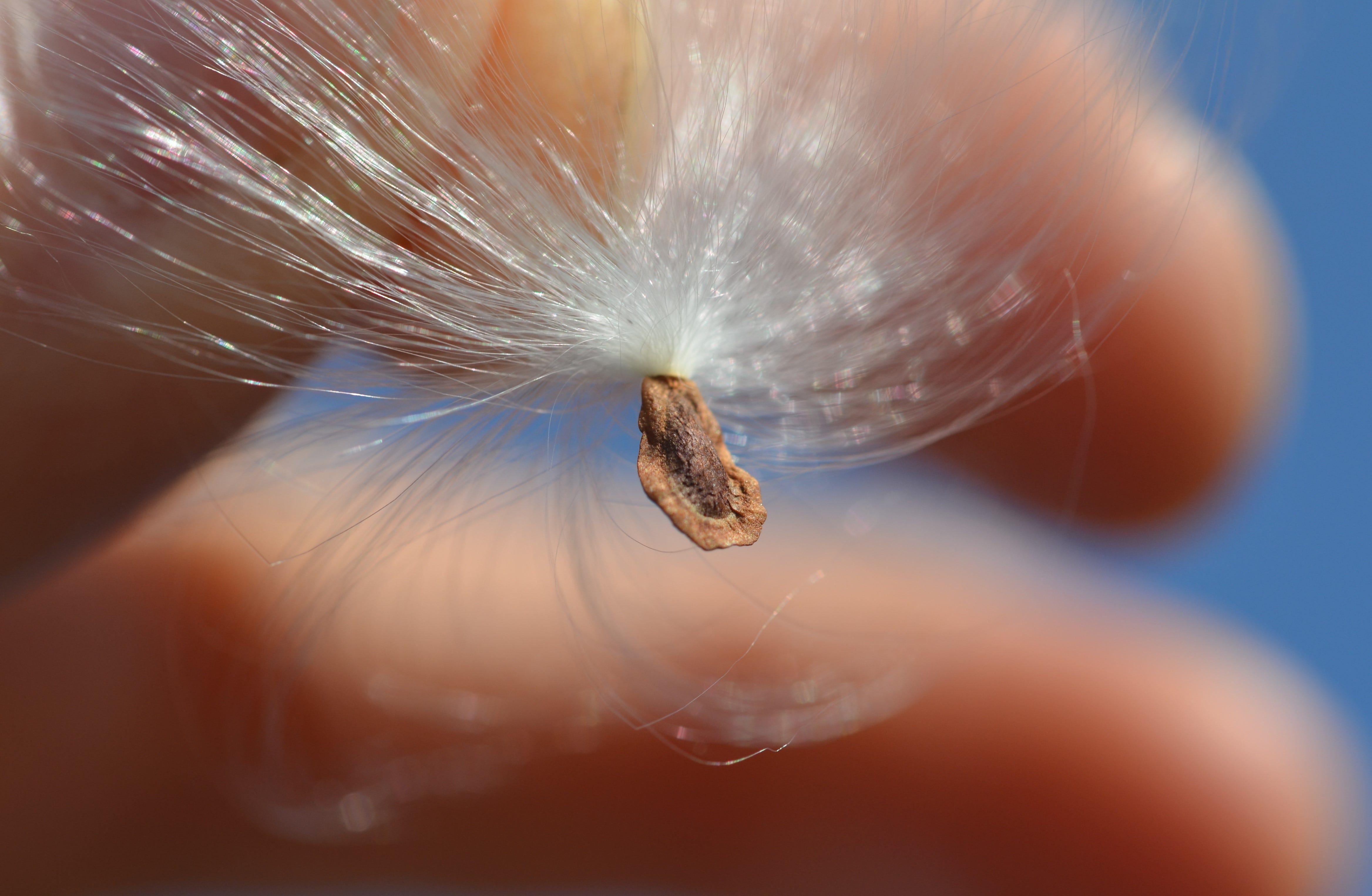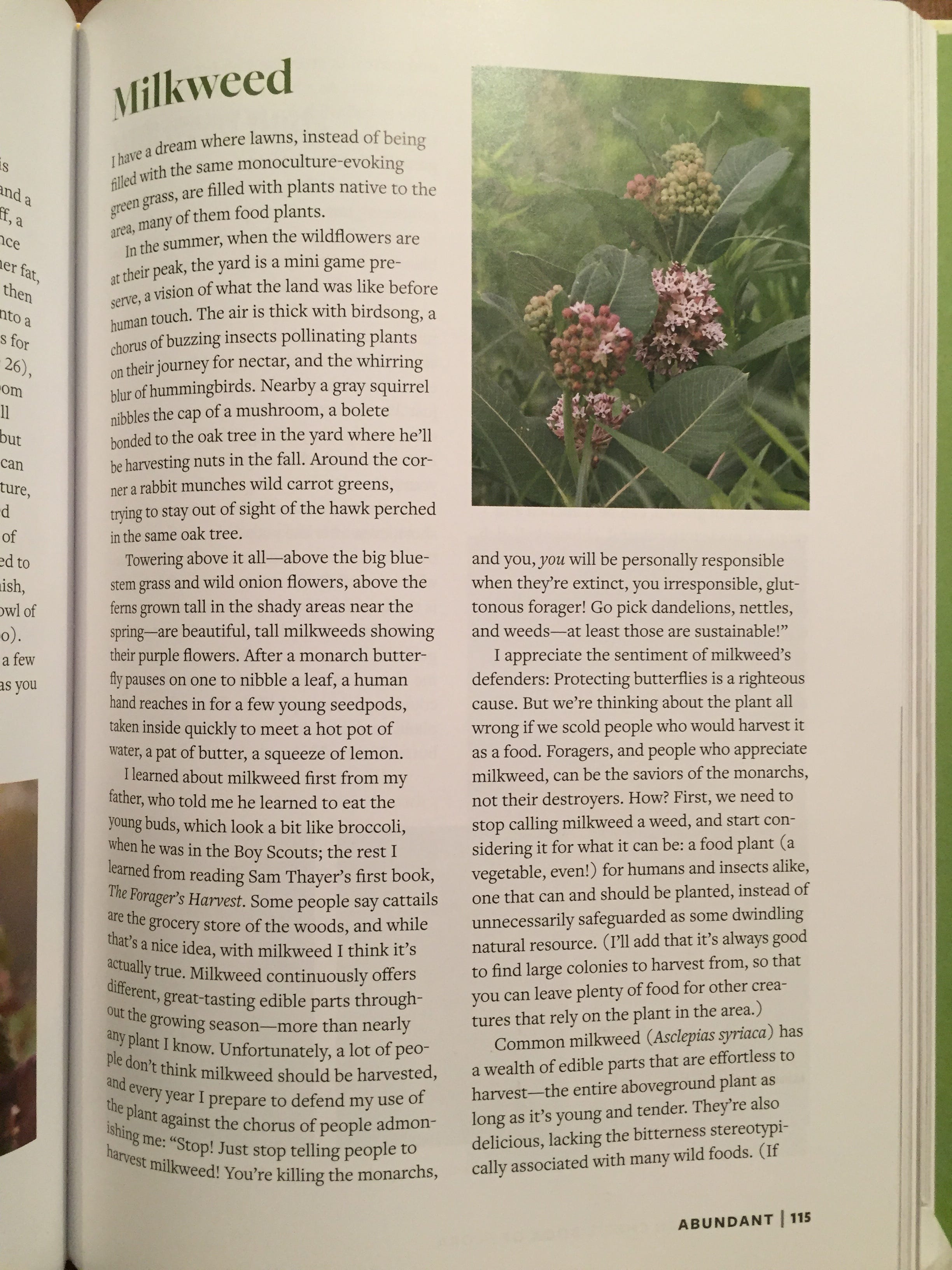I had dug up, rescued and re-planted some milkweed plants that were destined to be weed wacked last year and recently noticed their beautiful seed pods (having been stratified by the winter) were beginning to open up and send their graceful seeds on the wind to find new homes (super close up shot of one seed shown in my recent note-post).
Since many of these seeds will land on properties of our neighbors in urban suburbia which would likely perceive their presence through the linguistically diminishing and belittling lens of the latter half of their english common name, I decided to collect a few pods for intentionally planting in our yard and tending to the wild spaces (letting seeds fly out of my hand on the wind) on the edges of forest parks and abandoned lots so they can do their sacred work of feeding winged beings and protecting/building the soil.
As I closely observed the way the seeds were springing out of the pods so joyfully and willingly, lofting up on the more gentle breeze to float where the elemental forces guide them I was inspired to write about the wisdom embodied in those milkweed seeds (some of which I shared in my previous post). I will share some of the additional insights these beautiful beings offered me as I helped them to find a home in soils and areas in need of their many gifts below:
The genius, elegance and grace that is embodied in each living seed that I collect, sow and tend never ceases to amaze me and enrich my mind. Every moment spent in the presence of our photosynthetic elders offers an opportunity to learn something new if we open our heart and our eyes to be receptive with humility.
If you look really closely, observing how the seeds of the wild and the seeds in your garden express themselves in form, how they forge alliances with other beings, aligning with the elemental abundance of the Earth and harnessing the forces of nature to achieve their sacred goals, you will know everything you need to know to live a life of peace, health, fulfillment, joy, purpose, abundance and grace.
The living seeds of the wild teach younger species such as us humans how to live a life of purpose, grace and one that serves to feed and nourish that which is Sacred in the world.
We can emulate the wisdom of the wild seeds through preserving the seeds of regenerative (ecologically literate) cultural worldviews that involve tending the wilds with humility, holistic/honest forms of linguistic expression, and integrity in how we interact with our fellow beings (human and non-human). In doing so we become living fertile soil, allowing the seeds to set down roots to create a cultural ecosystem that feeds and nourishes the Sacred through living eloquently (as “washing the dishes like a baby Buddha” or living life as each moment is a piece of art).
In doing so we become the fertile ground (in our hearts and minds ) so that such cultural seeds, spiritual seeds and ways of being can set down Roots, flower and self sow into other hearts and minds within the reach of the seed pods released on the wind through our words, art, purposeful eloquence floating, allowing those seeds to be lifted up, effortlessly, levitating and moving gracefully as though they have a mind of their own , like a milkweed seed in late winter ... dancing her way to carry out her sacred work, coming the gently rest upon fertile soils/souls to regenerate and nourish the ecosystem of which she is an intrinsic part.
Many people only see Milkweed as the famous preferred food for Monarch Butterflies, but her gifts are myriad and she also offers many of them to help nourish our human family and empower us to live more regeneratively.
Common milkweed is a tasty edible plant (for humans), and is becoming one of my favorite spring greens. That’s right my friends! Milkweed is edible and super tasty. It tastes remarkably like asparagus, only better.
The various edible parts of common milkweed (Asclepias syriaca is the only species I've eaten in quantity) were traditional foods for indigenous peoples of North America. In Native American Food Plants, Daniel Moerman mentions multiple parts of the plant being harvested and consumed.
Besides the monarchs, milkweed naysayers may claim that it's not edible, that the plant is in fact poisonous to humans. This is not true, it only applies to milkweed in it's raw, uncooked form.
Raw, milkweed contains cardiac glycosides and other compounds that need to be denatured by cooking. Typically the plant is blanched in boiling, salted water, but I also enjoy the buds steamed, and consume the flowers raw in miniscule amounts as a garnish. I have never had a problem eating cooked, common milkweed in large amounts (4-6 oz or more) but, just like with many other foods, sensitivities vary, and some people seem to be more sensitive to eating milkweed than others.
Every time I tell someone this, they immediately say, “Shhh…don’t tell people. We have to save it for the Monarchs!” The truth is, eating milkweed can and will actually help the monarchs.
Let me tell you why…
foragers get a lot of pushback for even talking about eating milkweed. There’s this thought that, if the general public knows that milkweed is not only edible, but delicious, then they’ll eat it all up and there won’t be any for the monarchs.
Reality is just the opposite. Tell people that it’s delicious, and they’re less likely to weed them out of the garden. They’ll tend it carefully, and go out of their way to plant it, knowing that if it’s carefully stewarded you can harvest “wild” milkweed alongside their other vegetables.
Common Milkweed (Asclepias syriaca) is a perennial plant, and with a little care, it can be harvested at all stages of development and it will regrow with increased vigor.
Imagine a plant you can cut in the early stages like asparagus. Then later, when it resprouts, the flower buds can be harvested like broccoli. Then, the flowers themselves are tasty edible flowers.
Leave a few flowers, and after the bees are done with them, the young pods can be cooked like okra. A few weeks later, the immature seeds make a vegan cheese substitute.
Every stage is edible, and milkweed has a new gift to give every week of the summer.
(If you can’t find milkweed in the wild, that’s all the more reason to plant it yourself.)
I was happy enough knowing that milkweed is edible, and encouraging others to grow it on their own land. I recently learned though, foraging milkweed in the wild might actually directly help the monarchs. Nomi Foraging discusses this (i`ll link their article in the comments later), in relation to his region of Northern Michigan.
“Overwintering sites for these migrating butterflies are in a variety of locations in the southern US and in Mexico. Coupling that fact with their relatively short lifespan of only 2-5 weeks, we know that the Monarch populations that we see in Northern Michigan could be 4-5 generations removed from the original traveler. It is vital for these migrators to arrive here with a hefty supply of food to feed their young. The paradox here is that the most endemic species of Milkweed in our area, and their preferred food source is the Common Milkweed, and by the time these butterflies arrive in Michigan our Common Milkweeds may be too old and tough for most of the Monarch caterpillars to feed on!
This is where we foragers get to help in the cause by feeding ourselves. Over my years of teaching foraging, I have come to see that occasionally a selfish act is actually the opposite. It’s what I would call a win-win-win. We benefit, by getting to eat a delicious and healthy vegetable, the Monarchs benefit with fresh and tender leaves to feed their young, and the Milkweed benefits because rhizomatic plants grow more dense with disturbance. Common Milkweed spreads by underground rhizome, which is to say that the portion that you see above ground is not all there is to this story. This underground rhizome spreads rapidly underground creating clonal colonies of milkweed that all originate from the same source. When Common Milkweed is cut back to the ground, it has the amazing ability to resprout from its rhizome. Which works out wonderfully for both the Monarchs, the Milkweed, and us humans.”
I am no expert on Monarch butterfly life cycles, but he does make a good argument.
And, if all those amazing gifts are not enough, the seed fluff (known as "milkweed floss") can also be used as a cruelty free alternative to goose down and more ecologically friendly than cotton!
Numerous uses for Milkweed Floss have been explored throughout history due to its unique properties. Milkweed Floss is a sustainable fiber that is:
- Six times warmer than wool.
- Hypoallergenic.
- More buoyant than cork.
A cruelty-free alternative to goose down.
I hope this inspires you to try growing some of your own at home and spreading those seeds in the wild where you live. Plants like this can become long term allies and teachers to us humans if we just choose to use these human hands of ours to co-create, tend and plant seeds and use our eyes, hearts and minds to learn, adapt and expand our understanding.
There are some really amazing applications for the milkweed seed "floss" (seed fluff) so if farmers switch over from their heavy tilling annuals to milkweed in a few acres (milkweed only needs to be planted once every ten years, is drought tolerant and does not require pesticides/herbicides) they would get a solid income, butterflies get food, oil spills can get cleaned up (the seed fluff is very absorbent), sustainable and warm clothing can be made, soil gets protected and humans could get food too.





